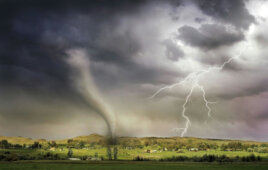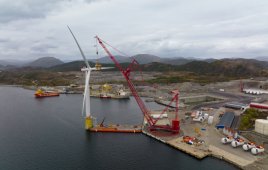By Andy Malpas, U.S. Offshore Wind Market Director, Kent
The United States is in the midst of a clean energy revolution with offshore wind emerging as a pivotal source of renewable power. With an abundance of coastal winds, the United States could soon stand at the forefront of offshore wind production.
 The global offshore wind industry has come a long way over the last two decades, but not without its fair share of challenges. From cable failures, welding defects, excessive seabed scour, corrosion and grout failures, to inadequate safety processes, underestimating wake effects and contracting and risk management blunders – nearly every aspect of a wind farm has a story to tell. With the United States’ rapid jump into offshore wind production, it’s vital to look back at what has worked well, and not so well, elsewhere in the world. This is a great opportunity for the industry to bring a more holistic and open approach to project development.
The global offshore wind industry has come a long way over the last two decades, but not without its fair share of challenges. From cable failures, welding defects, excessive seabed scour, corrosion and grout failures, to inadequate safety processes, underestimating wake effects and contracting and risk management blunders – nearly every aspect of a wind farm has a story to tell. With the United States’ rapid jump into offshore wind production, it’s vital to look back at what has worked well, and not so well, elsewhere in the world. This is a great opportunity for the industry to bring a more holistic and open approach to project development.
Current project demand, a healthy list of upcoming lease auctions and the investment stimulus provided by the Inflation Reduction Act means a new U.S. supply chain is firmly on its way. A recent report by NREL estimates that to meet the current 30 GW by 2030 target, the United States needs at least 2,100 turbines and foundation structures, 6,800 miles of cables, 26 installation and transport vessels, 70 crew and service vessels, and an annual workforce of up to 49,000 people. The report also estimates that upward of $22 billion of investment is needed in manufacturing and port development to establish a domestic supply chain by 2030.
The success of a project hinges on the strength, experience and competence of its supply chain. With every U.S. lease sale, we see new requirements encouraging domestic suppliers — while this is an important move to foster economic growth within individual states, it can often lead to a fragmented supply chain that’s costly and inefficient. To ensure the supply chain grows to be fit for purpose, greater collaboration is needed by individual states and better coordination is needed at the federal level.
Europe is no stranger to engineering and supply chain issues, with a record of high-profile litigations making the headlines over recent years. Fabrication and installation problems have plagued contractors forcing them to announce financial warnings and project write-downs. This will continue to be an issue, especially in emerging markets where new players enter the market to help meet the growing demand. The rising cost of materials and inflation affecting all aspects of the supply chain will only exacerbate this. Care needs to be taken to ensure shortcuts aren’t taken to meet unrealistic development schedules, and developers need to have close involvement throughout the process, especially with a fledgling supply chain.
Taking a holistic approach to wind farm development promotes the consideration of every element of the wind farm as early in the process as possible, allowing the complex interfaces between the various disciplines, work packages and development and operational phases, to be better understood and managed. The key is to not undertake activities in isolation, have robust design interfaces and have the foresight to properly consider the full life of the farm and its interaction with neighboring farms and other stakeholders. This promotes early and collaborative engagement with supply chains, allows O&M and safety considerations to be front and center, prevents late design changes and helps change to be dynamically managed with impacts already mapped out.
This should also be reflected in how contracts are managed – there needs to be the ability to share best practice, cross-collaborate and for the supply chain to demonstrate its experience and provide appropriate challenge to the decisions being made on a project.
And all of this must be balanced by the ‘cost’ – not just the direct cost of designing, building and operating a wind farm, but the cost to develop a workforce and a sustainable supply chain that will benefit the whole industry for decades to come, and still achieve a levelized cost of energy which allows affordable electricity to be produced and provide a return to investors.
The United States is on the cusp of becoming a leader in offshore wind energy production, and it’s an exciting time to be a part of the industry development. Taking cues from Europe, the United States can start out with a better understanding of the challenges involved and avoid common pitfalls like those faced by projects in other parts of the world, ultimately developing a more efficient, sustainable and cost-effective offshore wind industry.
Kent, Mainstream Renewable Power and K&L Gates LLP have released an updated Offshore Wind Handbook to help guide investors and new market entrants through technical and regulatory issues in a fast-paced developing U.S. offshore wind market.
Kent will be at International Offshore Wind Partnering Forum (IPF) on Thursday 30th March. Drop by their stand #152 to meet the team. More details here
 Andy Malpas is Kent’s Offshore Wind Market Director for the US. Based in Boston, Andy is an experienced chartered engineer with a proven track record leading projects and teams in the Offshore Wind and energy industries. He is a strong engineering professional skilled in engineering management, project management, operations management and has a technical focus in the area of fracture mechanics and integrity management.
Andy Malpas is Kent’s Offshore Wind Market Director for the US. Based in Boston, Andy is an experienced chartered engineer with a proven track record leading projects and teams in the Offshore Wind and energy industries. He is a strong engineering professional skilled in engineering management, project management, operations management and has a technical focus in the area of fracture mechanics and integrity management.
Filed Under: Featured




